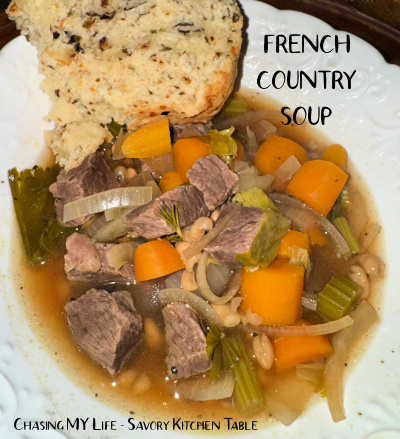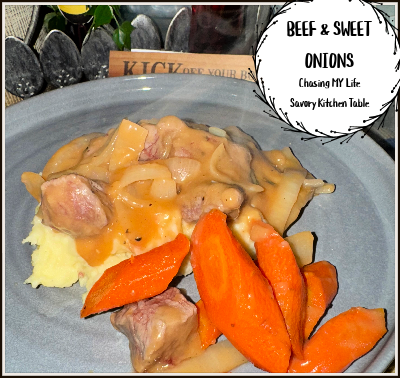I first learned of ITALIAN SUNDAY GRAVY in a magazine and then a cookbook. While there is a GREAT debate in the Italian American community about whether Sunday Gravy and Sunday Sauce are the same thing, my Italian hubby’s family says there is NO debate. There MUST be meat to be called a gravy otherwise it’s only a red sauce!!!! Sunday gravy is thick and hearty and the recipe that turns a simple Sunday into something really special.
An authentic recipe for Italian Sunday gravy aka sugo is a rich homemade red sauce that gets simmered for hours and hours with meatballs, Italian sausage, and melt-in-your-mouth pieces of tender slow cooked pork. It is traditionally served on Sundays making this iconic Italian recipe perfect for big family gatherings, special occasions and for leftovers any other night of the week. According to my research in the old world it was a truly arduous process with nonnas waking at dawn to make meatballs, stuffing and rolling flank steak to make braciole and even adding WHOLE pork chops and sausages to the vat of simmering sauce. They would simmer and stir ALL day until the gravy aroma carried all the way down the street. Obviously I have streamlined the process into a slow cooker situation, but I think it is still quite tasty! The large grind ground beef and mild Italian sausage works great for this version. Using other cuts of beef can make a tasty RAGU.
I don’t personally have an Italian background, but it is the end of summer and I have several bunches of ripe tomatoes to use along with an Italian husband who LOVES red sauce. There is something magical about the smell of this recipe simmering for hours on end. But, I understand that every Italian American makes their pasta sauce a different way, and they all have strong opinions about what it’s called. Many call it sugo, which is the Italian word for sauce. But, no matter what you call it – sugo, sauce or gravy – this is a recipe you definitely want to make again and again.
This recipe for authentic Italian red gravy is ideal for feeding a large group. I make it at the end of summer using up my tomatoes as well as many other veggies and then freeze it in batches for the winter months and use it to make lasagna as well as chicken Parmesan and the such.
Red gravy does require several hours and hours of low and slow simmering. But, the actual hands-on prep is pretty minimal. This is the best Sunday gravy recipe because it’s incredibly forgiving and adaptable. It can easily be scaled up or down to accommodate your number of guests.
Everyone makes theirs a little bit different. What makes this recipe special is that ultimately you get to decide what tastes best for you and your family!
My best advice is to ALWAYS use QUALITY ingredients! You can adjust the ingredients and amounts to suit your family.
Many start by adding all sorts of meats like short ribs, spare ribs, meatballs, and sausages, letting them all cook together for hours and as the day goes on, the sauce gets thicker, the flavors get richer and the smells are just amazing. Sunday Gravy is a comfort food, a hearty dish meant for the family to enjoy a delicious meal together while having a wonderful family day. Unlike a basic marinara or tomato sauce, Sunday Gravy is enriched with the flavors of various meats, making it more of a meat stew served over pasta.
Most of the time a Sunday Gravy recipe is passed down from generation to generation, with each family member putting their own spin on it. But, while the recipe might vary from family to family, the core elements remain the same – meat, tomatoes and love. No matter the variation, it’s always been about making something full of flavor and filled with love and warmth.

ITALIAN SUNDAY GRAVY
2 tablespoons avocado oil
1 LARGE Vidalia onion, chopped
4-5 garlic cloves, minced
1/2-2 teaspoons red chili pepper flakes
FRESH ground sea salt
1-2 tablespoons sugar
2 tablespoons tomato paste
1 pound pork butt, cut into large chunks
3-4 mild Italian sausage, casing removed
1 pound lean chili grind (large) ground beef
6 cups homemade chicken stock
2-3 pounds FRESH RIPE tomatoes or 3 large cans San Marzano crushed tomatoes
Prepared favorite pasta
- Heat oil in a large skillet over medium high heat.
- Add the pork pieces and sear well on each side until golden brown to develop a nice depth of flavor.
- Transfer the pork to a slow cooker.
- Lower the heat, then sauté the onions JUST until soft.
- Add the garlic and chili flakes, then continue cooking for another 2 minutes.
- Add the tomatoes, parsley and bay leaves.
- Season with salt and pepper, to taste. Transfer to the slow cooker also.
- Brown the beef and Italian sausage together until browned and well crumbled. DRAIN well of excess fat and add to slow cooker.
- Add the tomatoes and chicken broth.
- Cook on low 8-10 hours until the pork is falling apart and the gravy is thick and aromatic.
- Taste the sauce and adjust the seasonings as needed.
- Serve with your favorite prepared pasta.
- Finish with fresh basil or parsley and FRESH grated Parmesan cheese.
NOTES:
- Canned Tomatoes: You can use whole peeled tomatoes or crushed tomatoes in this recipe. If using whole peeled tomatoes you will need to crush them yourself. Some Italians prefer using tomato puree which produces an extra smooth sauce. It’s really about personal preference. Italians are passionate about which brand of tomatoes they use. San Marzano tomatoes are often said to be the best tomatoes and are what I use if not using fresh. If using whole peeled tomatoes, use an immersion blender to puree the tomatoes to make them smoother before adding them.
- Herbs and Spices: Keep the spices minimal. I ONLY use FRESH Italian parsley and basil as well as ground bay leaves. It gives the spaghetti sauce a subtle, but distinct flavor. I also use red pepper flakes, but se these to taste as not everyone likes a spicy sauce.
- Sugar: This ingredient is very controversial, but you can add a pinch of sugar to your sauce to balance the acidity. I usually do this towards the end of the simmering time after tasting and adjust the seasoning with salt and red pepper. Many times the tomatoes are so sweet I don’t need to add sugar, other times though it takes several tablespoons to balance out the acidity.
- Meats: A good Sunday gravy typically includes a variety of meats. I usually include Italian sausage, chili grind size lean ground beef and large pieces of trimmed pork butt. These meats add a depth of flavor and richness that make it the gravy versus a plain marinara sauce.
- Tomato paste is optional, but it adds nice body to the sauce. If you like your gravy a little bit thicker, don’t skip it! You can also thin out the sauce with more broth as needed.
- It’s important to stir the pot about every 20 minutes or so to prevent the bottom from burning.
Turn off the heat and allow the meats to sit in the sauce until ready to eat. I like to make my sauce on Sunday morning, then let it hang out on the stove all day.
- This recipe is very forgiving – you can adjust the amount or type of meat to suit your preference and the number of people you’re serving.













